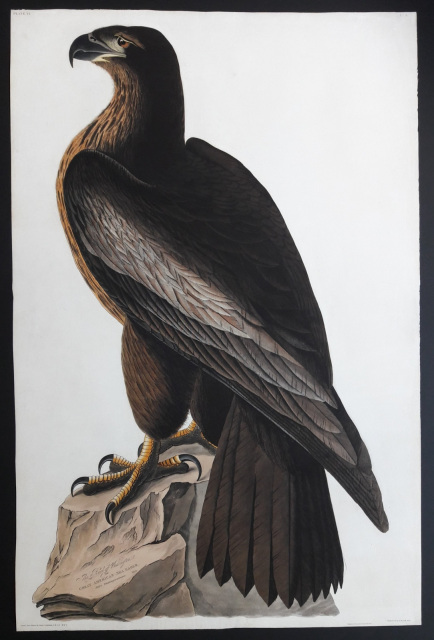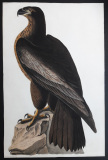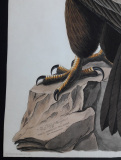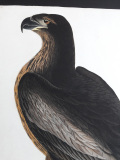- Home
- >
- Audubon's Havell Edition Birds (19th Century)
- >
- 11 - The Bird of Washington or Great American Sea Eagle
11 - The Bird of Washington or Great American Sea Eagle
SKU:
HE-11
$24,000.00
$21,000.00
$21,000.00
Unavailable
per item
Hand-colored engraving with etching. Variant 1. J Whatman Turkey Mill 1827 watermark. This plate shows at the bottom right, credits to both R. Havell, Junr., (engraved by) and R. Havell, Senr., (printed and colored by).
Audubon painted this majestic bird image in New Orleans in 1822. While painting this image, he probably never could have imagined that it would engulf him in considerable controversy not only during his lifetime, but even after his death. Since a specimen could not be located currently for this bird in any museum or an ornithological laboratory (and sadly, specimens of this bird that were once said to be in the collections of some museums in Boston, Philadelphia, and London in the early 19th century no longer exist), Audubon was even accused of fabricating this bird. Audubon considered this rather large eagle (significantly larger than the American Bald Eagle or the Golden Eagle) as a new species, and to honor the first President of America, he named it the Bird of Washington. Even though some Audubon scholars and modern ornithologists disputed this claim and suggested that Audubon probably mistook an immature Bald Eagle for a new species (despite the fact that Audubon knew very well mature vs immature bald eagles (see his Havell Plates 31 and 126)), the thought is now slowly gaining traction based on the scholarly work of Scott Maruna (see Maruna, S., Substantiating Audubon's Washington Eagle, The Ohio Cardinal, Vol.29, No.3, pp.140-150 (2006)) and William Souder (see his book "Under a Wild Sky, John James Audubon and the Making of the Birds of America" (2004)), that this Bird of Washington was in all likelihood a new species indeed, and probably on the very verge of extinction even during Audubon's time (this might probably account for the absence of specimens of this Bird of Washington in museums and ornithological laboratories, unlike other extinct birds that Audubon also painted, like the Passenger Pigeon and Carolina Parrot which were very abundant during Audubon's time, and their specimens still exist in museums today). Audubon drew his birds in their true life size (by mounting the wired specimen on to a board marked with a grid pattern to get its precise dimensions) - - thus, even a simple visual inspection of the size of this bird's claw (talon) alone is enough to convince one that the "Bird of Washington" was truly enormous in size!
Indeed, Audubon was so impressed and overcome by the majesty of this magnificent bird that he wrote "The name which I have chosen for this new species of Eagle, "The Bird of Washington," may, by some, be considered as preposterous and unfit; but as it is indisputably the noblest bird of its genus that has yet been discovered in the United States, I trust I shall be allowed to honour it with the name of one yet nobler, who was the saviour of his country, and whose name will ever be dear to it."
Audubon painted this majestic bird image in New Orleans in 1822. While painting this image, he probably never could have imagined that it would engulf him in considerable controversy not only during his lifetime, but even after his death. Since a specimen could not be located currently for this bird in any museum or an ornithological laboratory (and sadly, specimens of this bird that were once said to be in the collections of some museums in Boston, Philadelphia, and London in the early 19th century no longer exist), Audubon was even accused of fabricating this bird. Audubon considered this rather large eagle (significantly larger than the American Bald Eagle or the Golden Eagle) as a new species, and to honor the first President of America, he named it the Bird of Washington. Even though some Audubon scholars and modern ornithologists disputed this claim and suggested that Audubon probably mistook an immature Bald Eagle for a new species (despite the fact that Audubon knew very well mature vs immature bald eagles (see his Havell Plates 31 and 126)), the thought is now slowly gaining traction based on the scholarly work of Scott Maruna (see Maruna, S., Substantiating Audubon's Washington Eagle, The Ohio Cardinal, Vol.29, No.3, pp.140-150 (2006)) and William Souder (see his book "Under a Wild Sky, John James Audubon and the Making of the Birds of America" (2004)), that this Bird of Washington was in all likelihood a new species indeed, and probably on the very verge of extinction even during Audubon's time (this might probably account for the absence of specimens of this Bird of Washington in museums and ornithological laboratories, unlike other extinct birds that Audubon also painted, like the Passenger Pigeon and Carolina Parrot which were very abundant during Audubon's time, and their specimens still exist in museums today). Audubon drew his birds in their true life size (by mounting the wired specimen on to a board marked with a grid pattern to get its precise dimensions) - - thus, even a simple visual inspection of the size of this bird's claw (talon) alone is enough to convince one that the "Bird of Washington" was truly enormous in size!
Indeed, Audubon was so impressed and overcome by the majesty of this magnificent bird that he wrote "The name which I have chosen for this new species of Eagle, "The Bird of Washington," may, by some, be considered as preposterous and unfit; but as it is indisputably the noblest bird of its genus that has yet been discovered in the United States, I trust I shall be allowed to honour it with the name of one yet nobler, who was the saviour of his country, and whose name will ever be dear to it."
1 available
11 - The Bird of Washington or Great American Sea Eagle
Hand-colored engraving with etching. Variant 1.
J Whatman Turkey Mill 1827 watermark.
Havell Edition, Birds of America
The Havell edition prints are considered as the most desirable of all of Audubon's original art work. During the period 1827 to 1838, Audubon produced the images for his monumental "The Birds of America" (BOA) with the assistance of engravers William Lizars of Scotland for the first few prints and then with Robert Havell, Sr and Jr., in England. These are copper plate engravings (435 plates) printed on high quality wove paper with a watermark (either J. Whatman or J. Whatman Turkey Mill, followed by the year). These plates (commonly referred to as the "Havell Edition") are known for the exquisite and unsurpassed beauty and details in the images, and the fresh vibrant colors. Audubon printed only a small number of the full sets of the BOA (between 175 to 200 copies). Most of these full sets are in museums, and a few in private hands, with only a few loose prints available for purchase by the general public. In the 19th century, some of the owners of these original prints, understandably given the time period and not anticipating how rare Audubon's Havell prints would become, did not pay the utmost attention and care in preserving these precious copperplate engravings; as a result, some prints got trimmed right down to the platemarks (to save on framing expenses), or got destroyed due to exposure to the elements (bleaching from exposure to bright sunlight, smog, smoke etc), and didn't survive or retain the original pristine condition. The rarity of these Havell Edition prints becomes very quickly obvious especially when one is searching for a particular bird print - - they are very difficult to find indeed!
In the 2010 Sotheby's Auction, the Lord Hesketh 4-volume set of Audubon's The Birds of America sold for a record-breaking $11.5 million!
All the plates listed in this section are original full sheets with the Whatman watermark, unless otherwise noted in the description. Please ask for a detailed "Condition Report" for any particular print you might be interested in, before purchasing.
J Whatman Turkey Mill 1827 watermark.
Havell Edition, Birds of America
The Havell edition prints are considered as the most desirable of all of Audubon's original art work. During the period 1827 to 1838, Audubon produced the images for his monumental "The Birds of America" (BOA) with the assistance of engravers William Lizars of Scotland for the first few prints and then with Robert Havell, Sr and Jr., in England. These are copper plate engravings (435 plates) printed on high quality wove paper with a watermark (either J. Whatman or J. Whatman Turkey Mill, followed by the year). These plates (commonly referred to as the "Havell Edition") are known for the exquisite and unsurpassed beauty and details in the images, and the fresh vibrant colors. Audubon printed only a small number of the full sets of the BOA (between 175 to 200 copies). Most of these full sets are in museums, and a few in private hands, with only a few loose prints available for purchase by the general public. In the 19th century, some of the owners of these original prints, understandably given the time period and not anticipating how rare Audubon's Havell prints would become, did not pay the utmost attention and care in preserving these precious copperplate engravings; as a result, some prints got trimmed right down to the platemarks (to save on framing expenses), or got destroyed due to exposure to the elements (bleaching from exposure to bright sunlight, smog, smoke etc), and didn't survive or retain the original pristine condition. The rarity of these Havell Edition prints becomes very quickly obvious especially when one is searching for a particular bird print - - they are very difficult to find indeed!
In the 2010 Sotheby's Auction, the Lord Hesketh 4-volume set of Audubon's The Birds of America sold for a record-breaking $11.5 million!
All the plates listed in this section are original full sheets with the Whatman watermark, unless otherwise noted in the description. Please ask for a detailed "Condition Report" for any particular print you might be interested in, before purchasing.






